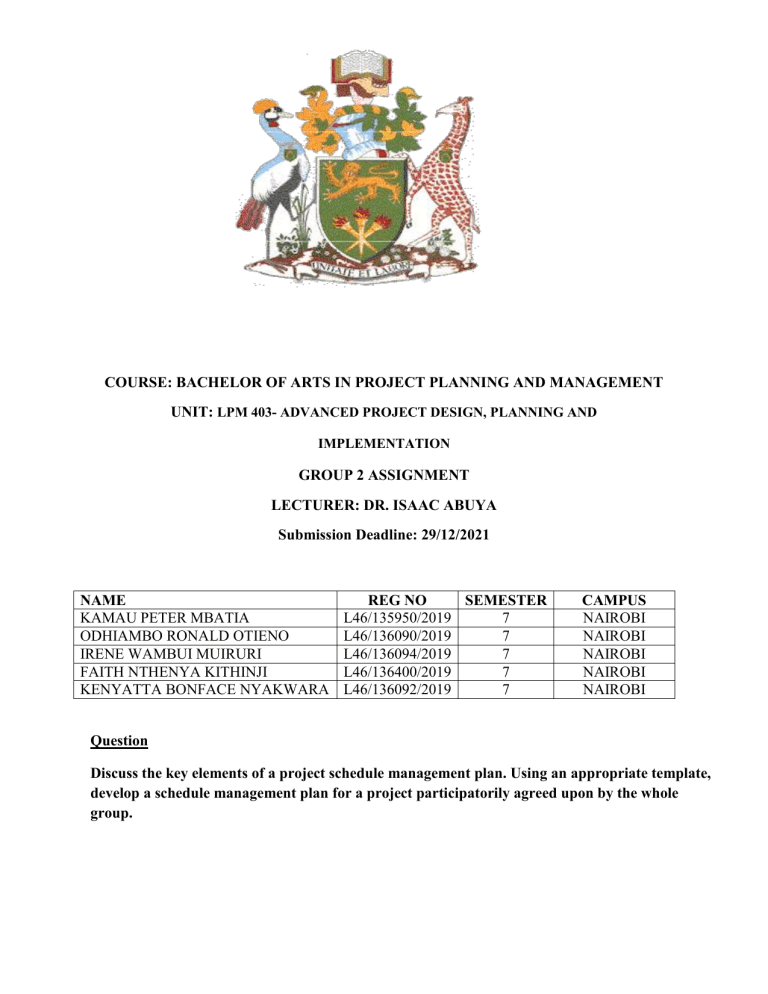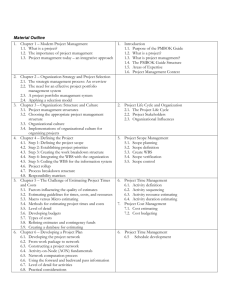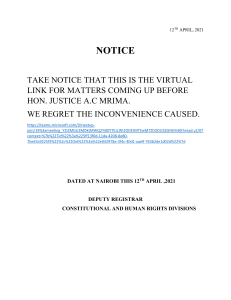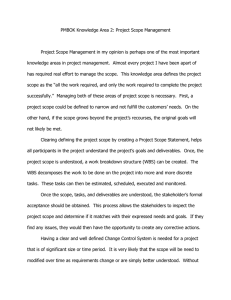
COURSE: BACHELOR OF ARTS IN PROJECT PLANNING AND MANAGEMENT UNIT: LPM 403- ADVANCED PROJECT DESIGN, PLANNING AND IMPLEMENTATION GROUP 2 ASSIGNMENT LECTURER: DR. ISAAC ABUYA Submission Deadline: 29/12/2021 NAME KAMAU PETER MBATIA ODHIAMBO RONALD OTIENO IRENE WAMBUI MUIRURI FAITH NTHENYA KITHINJI KENYATTA BONFACE NYAKWARA REG NO SEMESTER L46/135950/2019 7 L46/136090/2019 7 L46/136094/2019 7 L46/136400/2019 7 L46/136092/2019 7 CAMPUS NAIROBI NAIROBI NAIROBI NAIROBI NAIROBI Question Discuss the key elements of a project schedule management plan. Using an appropriate template, develop a schedule management plan for a project participatorily agreed upon by the whole group. Schedule Management Plan A schedule consists of all the activities included in the implementation and execution of a project within the pre-determined time frame of the project. The project schedule helps in prioritizing work involved in a project and finish it off in an orderly manner by also helping in appointing the right person for the job and in the proper allocation of the available resources. The purpose of a schedule management plan is to establish the criteria and the activities for developing, monitoring and controlling the project schedule. The components of the Schedule Management Plan 1. Roles and responsibilities. This component describes different roles and their ability to access the project schedule. Commonly, the schedule is owned and is under the responsibility of the Project Manager. He is the only one allowed to update the project schedule. However, in large projects, a Project Administrator might make the initial schedule updates based on the project status reports and then provide this draft to the project manager for final updates. It is also possible that team members will update the status of their assigned activities and the project manager will perform final analysis after those updates. 2. Scheduling Method and Tools The scheduling method defines the framework and algorithms used in the scheduling tool to create the schedule model. For example, the critical path method. This method calculates the minimum project duration and determines the amount of scheduling flexibility on the logical network paths within the schedule model. Other scheduling methods that can be used are; Critical chain method. Program Evaluation and Review Technique (PERT) Gannt Charts 3. Progress feedback This component describes how the schedule feedback will be delivered. In many cases this will be in the team member status report which may come up during a team meeting or through an email circulation to the project team members. 4. Schedule Process This is where one define the process required to evaluate and approve proposed schedule changes. It defines the authority for accepting and approving changes to schedule. This approval process does not include internal activity deadlines. It applies to changes in the overall project deadline. It is possible that the project manager may have some discretion to exceed the deadline by some number of days or weeks, but after that threshold some formal body may need to approve the change. This section has subsections that describe the process for developing the project schedule. The project manager will at this point initiate schedule development by adding to the schedule the deliverables found in the project work breakdown structure (WBS). The activities involved includes; Defining Activities - by identifying and documenting the specific actions to be performed to produce project deliverables. Sequence Activities - Sequencing activities is the process of identifying and documenting relationships among the project activities. Sequencing can be performed using project management software or by using manual techniques. Estimating activity resources - It involves estimating the type and quantities of material, human resources, equipment or supplies required to perform each activity. Who is responsible for estimating the activity resources? SCHEDULE MANAGEMENT PLAN Project Name: Construction of Three Additional Classes at Elimu Primary School Project Sponsor: Mr. Charles Thompson – Friend from United States of America Project Definition: To reduce crowding of classes by adding Three Additional classes to enable pupils’ distribution. Project Manager: Mr. Ronfaimbat Last Revised On: 22/12/2021 _______________________________________________________________________________________ This schedule management plan is a component of the project management plan. It establishes the criteria and the activities for developing, monitoring and controlling the project schedule. 1. MANAGEMENT APPROACH The purpose of this schedule management plan is to establish the criteria and the activities for developing, monitoring and controlling the project schedule. When this plan is approved, no schedule changes will be permitted unless a request for change is processed in accordance with the procedures set forth in the change management plan. The project manager will assume overall responsibility for schedule management. The people listed below will assume the following schedule management responsibilities: 2. ROLES AND RESPONSIBILITIES Name/Role Responsibilities Project Manager Overall responsibility of the project including this schedule management plan Project Sponsor Provision of funding and facilitating subject matter experts to support successful planning and execution of the project Project Team To manage the project team by coordinating activities and harmonizing communication within the whole team Lead 3. Project Team To carry out all the activities necessary for successful execution of the project as assigned and directed from time Members to time Project To manage this schedule management plan and update it with approved changes and to ensure all stakeholders Scheduler adhere to the schedule. SCHEDULING METHOD The scheduling method defines the framework and algorithms used in the scheduling tool to create the schedule model. In this project we shall use the Gannt Chart that will have its input from the Work Breakdown Structure (WBS). 4. SCHEDULING TOOL – GANNT CHART Project Start Date 1/12/2021 Project Lead: Mr. Ronfaimbat 12/30/2021 WBS TASK 1 EPZ LOCATION/WORKS DATE DAYS % DONE WORK DAYS 09/12/21 7 100% 7 OWNER START END 09/06/21 14 15 16 17 18 19 M T W T F S S - 1.1 Plant layout Joseph 1.2 Plumbing works layout Joseph 09/06/21 10/05/21 30 80% 24 1.3 Electrical points layout Joseph 09/06/21 10/14/21 39 62% 24 1.4 Set-up and works Cost Joseph 09/06/21 09/29/21 24 100% 24 2 FIT OUT AND SMALL EQUIPMENT 2.1 Shipping from SA Kurt 09/15/21 10/10/21 26 58% 15 2.2 Installation/Commissioning Kurt 10/25/21 10/31/21 7 0% 2.3 Maintenance Contract Kurt 10/26/21 11/02/21 8 0% 3 ICT 3.1 Manufacturing Module John 09/06/21 09/30/21 25 96% 24 3.2 SOPs/QA Peter 09/15/21 10/14/21 30 80% 24 3.3 Internal Contract/SLA John 09/16/21 10/15/21 30 80% 24 5. 13 SCHEDULE PROCESSES We shall use the scheduler to initiate schedule development by adding to the schedule the deliverables found in the project work breakdown structure (WBS which is usually found in the scope management plan. 6. DEFINE ACTIVITIES Defining activities refers to the process of identifying and documenting the specific actions to be performed to produce the project deliverables. We shall examine the work breakdown structure (WBS) found in the scope management plan which represent the highest or most broadly defined part. 7. ACTIVITY LIST We shall Identify the person or persons responsible for reviewing the project deliverables, the work packages and then defining the related work activities and also identify Who will validate the defined work activities? 8. MILESTONE LIST Milestones represent significant points or events in the project and this shall be set forth in the milestone list. 9. SEQUENCE ACTIVITIES Sequencing activities is the process of identifying and documenting relationships among the project activities. We shall sequence our activities using project management software or by using manual techniques. Foe efficiency and ease of operations, we shall also identify the a person responsible for sequencing work activities, responsible for determining dependencies and establishing leads and lags to define the relationships between project activities. 10. SCHEDULE CONSTRAINTS We shall list all schedule constraints in our project and this will help to keep track of the completion time and the deliverables to be achieved before certain times. 11. ESTIMATE ACTIVITY RESOURCES This is an activity which we shall undertake and it involves estimating the type and quantities of material, human resources, equipment or supplies required to perform each activity. Who is responsible for estimating the activity resources? 12. ESTIMATE ACTIVITY DURATIONS Estimating activity durations is the process of estimating the number of work periods needed to complete individual activities with the estimated resources. 13. LEVEL OF ACCURACY We shall specify the range used in determining the activity duration estimates. 14. RESERVE ANALYSIS This process will help us to identify if there are any contingency reserves we shall require to be added anywhere in the schedule. It will also assist us to identify, how are they calculated, for what purpose are they provided and where are they included? 15. DEVELOP SCHEDULE Developing the project schedule involves analyzing activity sequences, durations, resource requirements and schedule constraints to create the project schedule model. Identify the person or persons responsible for developing the project schedule. This schedule will asssist us to answer the following: 16. Will the schedule be reviewed and validated by the project team? Who will review the schedule with the project team and what project team members will be responsible for validating it? Will the project sponsor be involved in preliminary schedule reviews? Will he or she participate in validating the schedule? Who will prepare the schedule model? What will be the format of the schedule model? Gantt chart? Milestone chart? Project schedule network diagram? CONTROL SCHEDULE Controlling schedule involves monitoring the status of project activities to update project progress and manage changes to the schedule baseline to achieve the plan. 17. SCHEDULE BASELINE A schedule can only be changed through the formal change control procedures set forth in the change management plan once it has been approved. The schedule baseline will be used throughout the project as a basis for comparison to actual results. 18. VARIANCE THRESHOLD This process will help us to identify the amount of schedule variation that triggers a warning. What happens if a warning is triggered? 19. REPORT SCHEDULE The project manager will review and update the project schedule twice a week. On these dates, members of the project team will provide the project manager with actual performance and completion information. The project manager will compare the actual information to the schedule baseline and calculate the completion percentages and any variances. The project manager will distribute the actual schedule information according to the terms set forth in the communication management plan. 20. ASSUMPTIONS While planning and managing the project schedule, it’s possible that assumptions will be made. All assumptions regarding the project schedule are documented here then transferred to the Risk Management Plan for further management. 21. ISSUES While planning and managing schedule, it’s possible that issues will be encountered. All issues regarding the project schedule are documented here then transferred to the Risk Management Plan for further management. Risk No. 1 Risk Category Strategic Risks 4 Compliance Risks 5 Financial Risks 6 Reputational Risks 22. Description Impact Urgency Business viability and lack of performance measurement mechanisms High High Inconsistent and Seasonality supply of beef High High Machine Failure High Medium Demand outstrips production capacity High Low Turnover for critical staff Medium Medium Over reliance on staff Systems failure – Invoicing and comms KEBS Medium Medium High Medium Low Medium Veterinary High Low HALAL High Low KRA High High Liquidity Challenges Debtors – Defaulting on terms Price escalations Challenges of Brand visibility High High High High Medium Medium Low High Social media exposure High High PLAN APPROVAL By signing below, I Mr. Charles Thompson in my capacity as Project Sponsor approve of this Schedule Management Plan. Name: Charles Thompson Title: Project Sponsor ________________________________________ ______________________________ Signature Date Approved REFERENCES 1. https://s7629.pcdn.co/wp-content/uploads/2015/02/Schedule-Management-Plan.pdf/22/12/21/1100hrs 2. Mulwa, A., Ndunge K., et al (2018). “LPM 203: Project Identification, Formulation and Appraisal”. UoN Learning Resources, University of Nairobi. Mulwa, A., Ndunge K., et al (2018). “LPM 403: Advanced Project Planning Design and Implementation”. UoN Learning Resources, University 3. of Nairobi.





